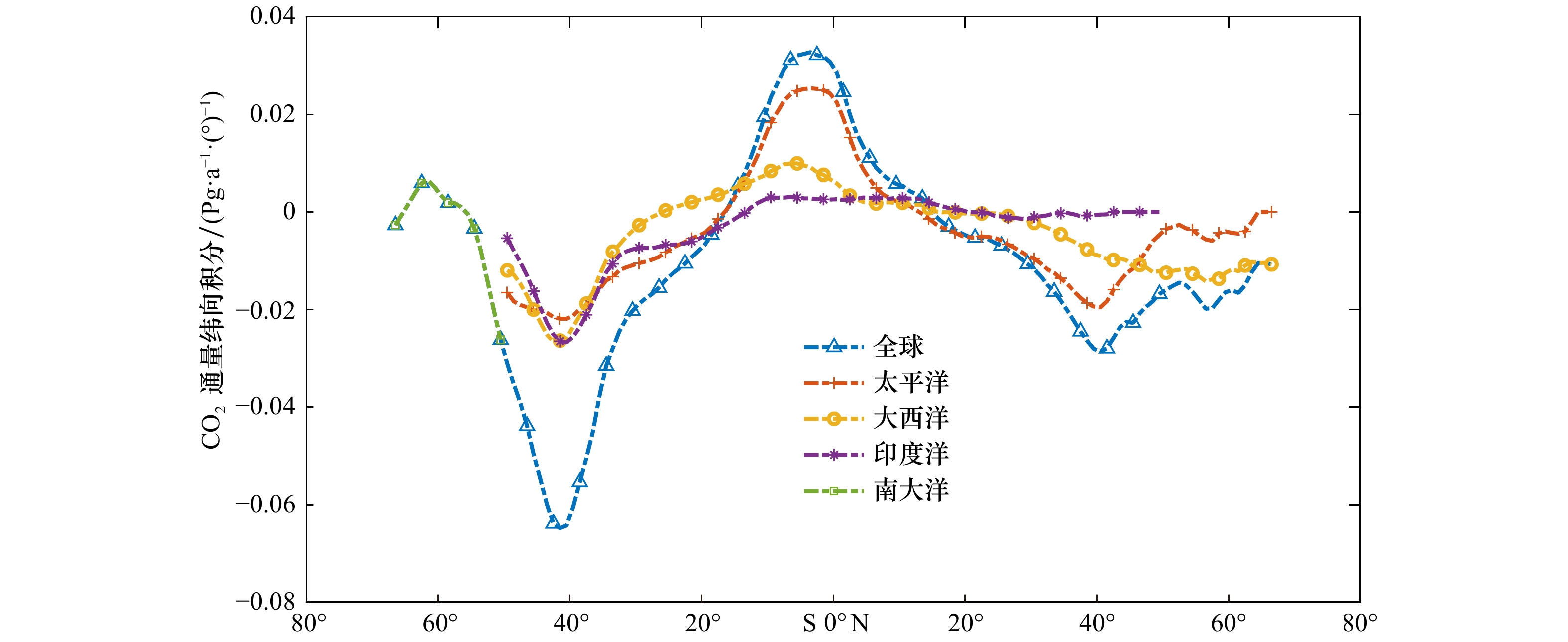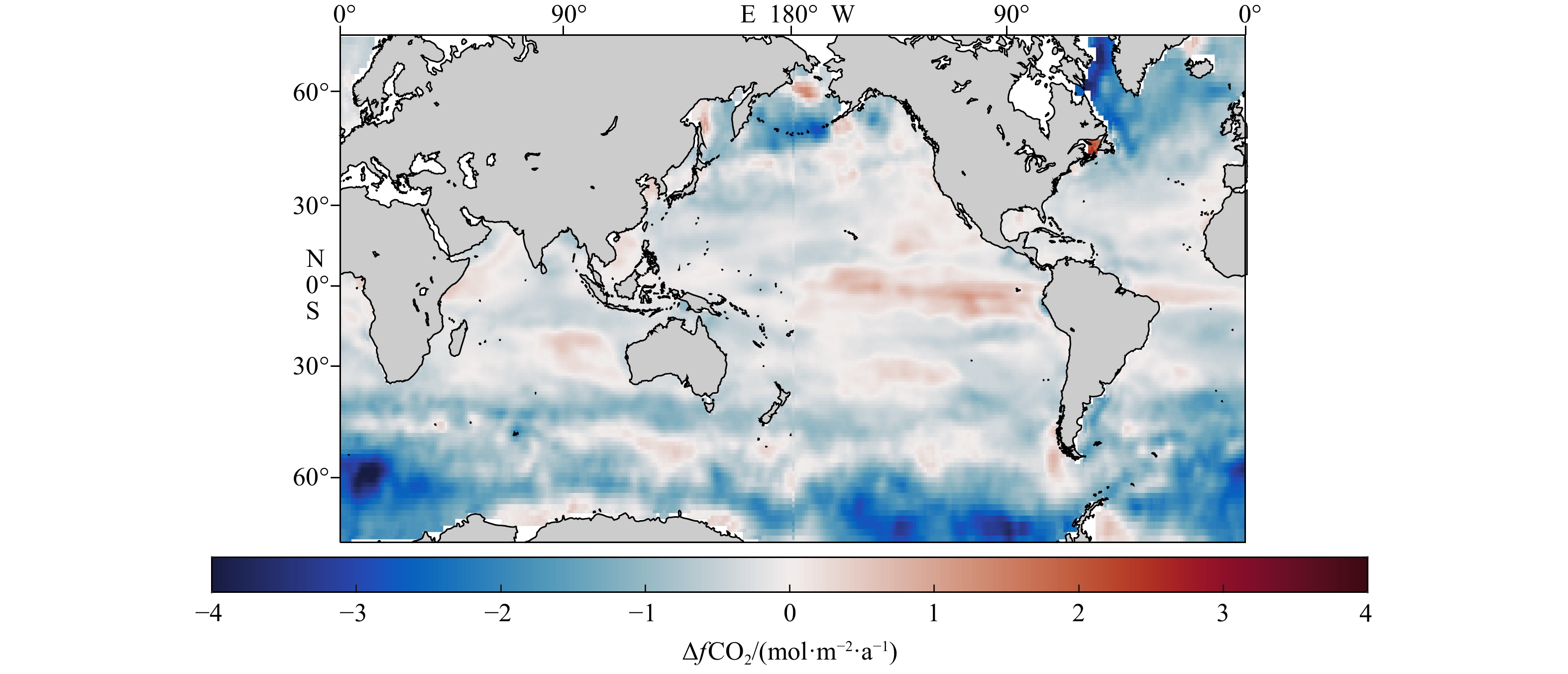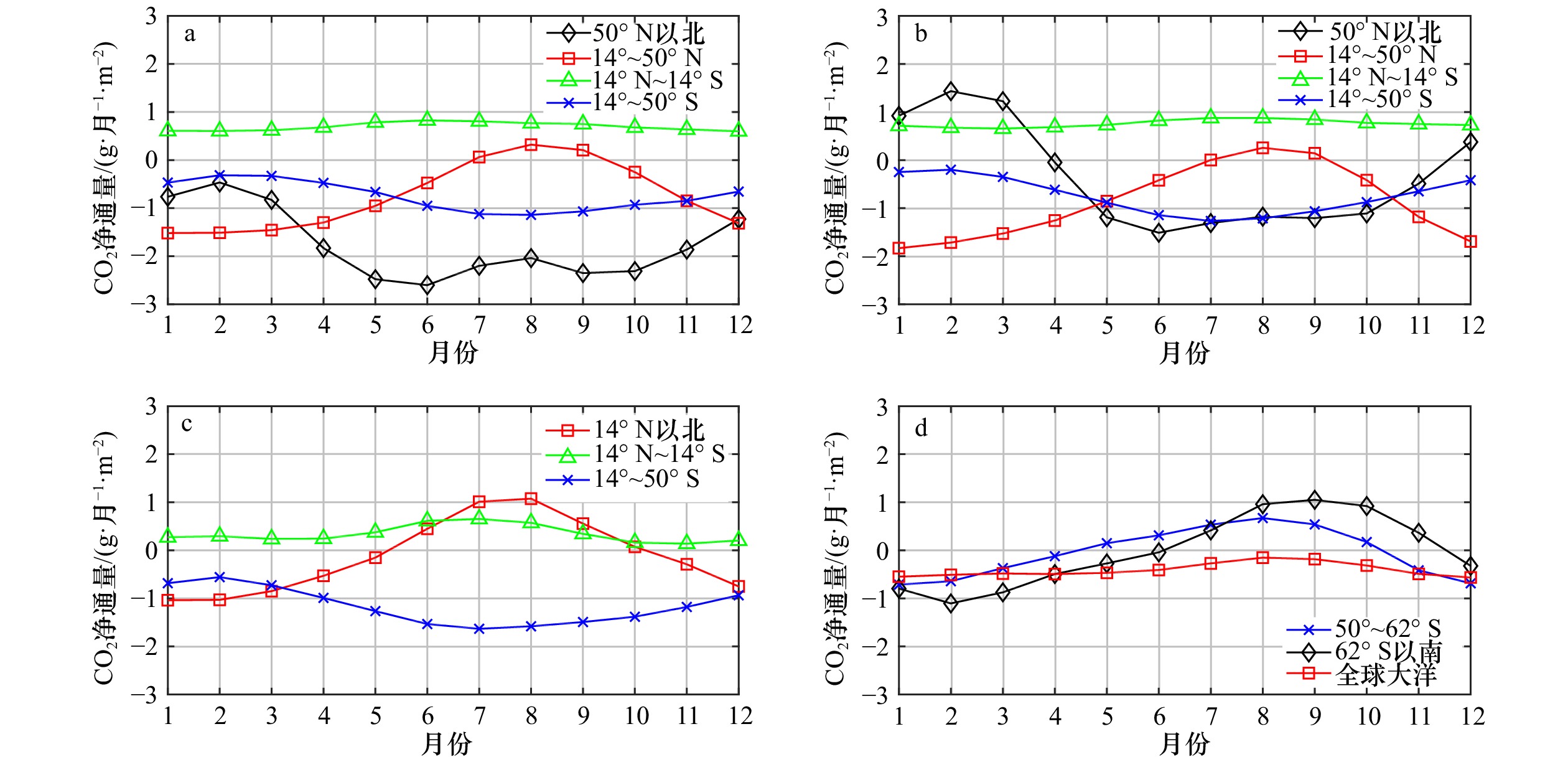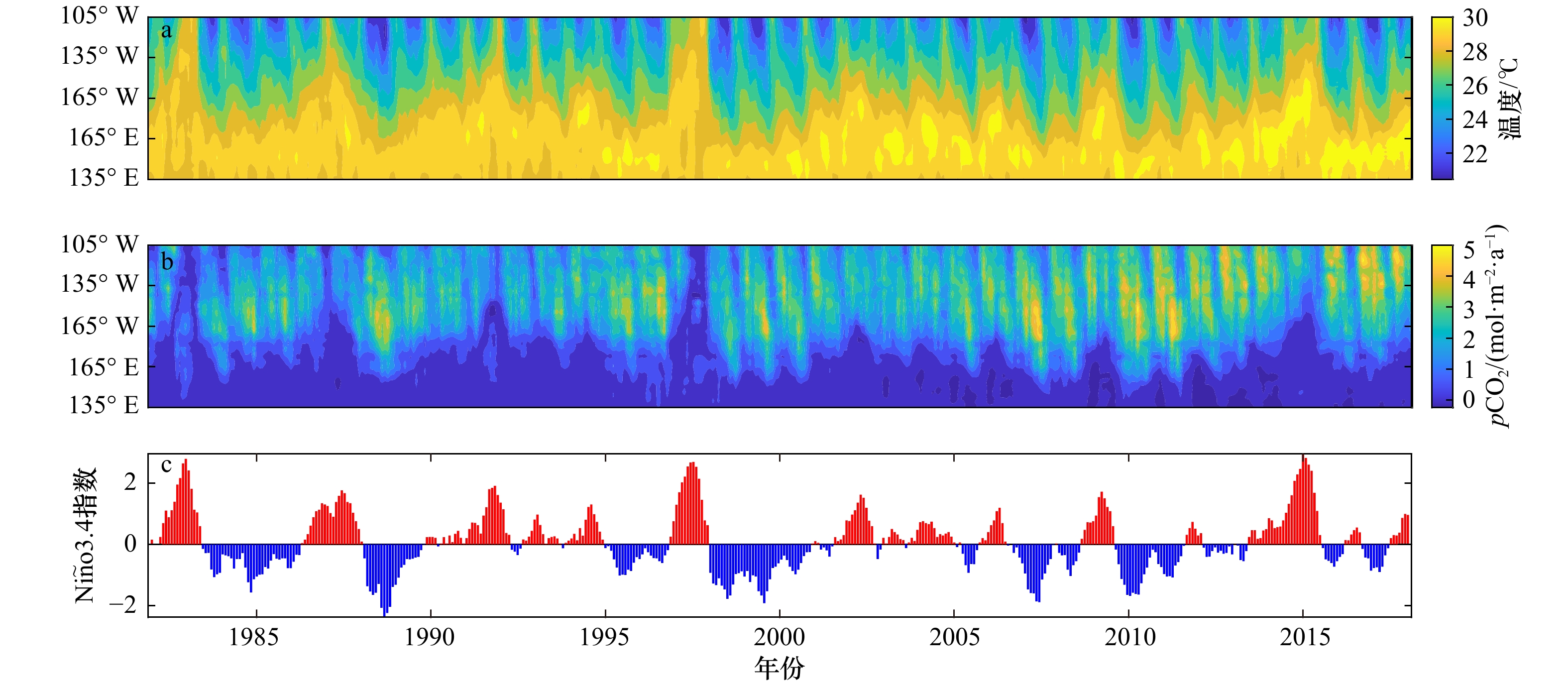Estimation of gas exchange rate and carbon dioxide gas flux at the sea-air interface
-
摘要: 海−气界面CO2通量的估算采用块体公式,其等于气体交换速率、CO2溶解度以及海水与大气的CO2分压差的乘积,其中的气体交换速率通常与风速相联系,不同作者提出了气体交换速率为风速不同幂次多项式的参数化方案。本文对比了气体交换速率为风速函数的主要研究结果,发现与风速多项式的依赖关系相比,观测数据所基于的观测方法对于气体交换速率的影响更大。在此基础上,本文用多种不同的气体交换速率参数化公式计算了1982−2018年全球的CO2通量,海洋整体上是大气CO2的汇,赤道海区是源,南北半球40°附近的海域构成沿纬向的强吸收带。37 a间,海洋CO2通量的年平均值(以碳计)为(−1.53±0.15) Pg/a, 1999年前,海洋吸收量逐年减小,1999年达到最小值,之后海洋吸收量开始增大,海洋吸收量的增大主要发生在南大洋。Abstract: The CO2 flux at the sea-air interface, which is equal to the product of the gas transfer velocity, solubility, and the CO2 partial pressure difference between sea and the atmosphere, is estimated using the bulk equation, where the gas transfer velocity is usually associated with the wind speed. Different authors have proposed different parameterization schemes, in which the gas transfer velocity is a polynomial of different powers of the wind speed. In this paper, we summarize the main findings on the gas transfer velocity as a function of wind speed. We discover that the observation method has a greater influence on the gas transfer velocity than the power of the wind speed polynomial. On this basis, this paper calculates the global CO2 flux from 1982−2018 using several different parametric formulas for the gas exchange rate. The ocean is a sink for atmospheric CO2, the equatorial sea area is a source, and the ocean near 40° in the northern and southern hemispheres forms a strong absorption zone along the latitudinal direction. The annual average value of oceanic CO2 absorption (in terms of carbon) over 1982−2018 is (−1.53±0.15)Pg/a. The oceanic absorption decreases year by year until 1999, reaching a minimum in 1999, after which the oceanic absorption begins to increase, with the increase in oceanic absorption occurring mainly in the Southern Ocean.
-
Key words:
- gas transfer velocity /
- wind speed /
- carbon dioxide flux
-
图 1 气体交换速率与风速二次方(a)、三次方(b)以及两种依赖关系(c)的参数化结果
五角星为14C 数据结果;倒三角为双示踪数据结果;圆圈为涡相关结果;虚线表示风速二次方依赖关系;实线表示风速三次方依赖关系
Fig. 1 Parameterization results for quadratic (a) , cubic dependence (b) and both of them (c) between gas transfer velocity and wind speed
The pentagram represents 14C data; the inverted triangle represents dual tracer date; the circle represents the results of eddy covarance; dotted line represents the quadratic relationship; solid line represents the cubic relationship
图 2 全球ΔpCO2标准气候平均值(1 atm=101 325 Pa)
正值代表海洋CO2分压大于大气CO2分压;负值代表海洋CO2分压小于大气CO2分压
Fig. 2 Global ΔpCO2 standard climatological normals (1 atm=101 325 Pa)
Positive value indicates that ocean CO2 partial pressure is greater than atmospheric CO2 partial pressure; negative value indicates that the ocean CO2 partial pressure is less than the atmospheric CO2 partial pressure
图 3 利用不同气体交换速率得到的1982−2018年海−气界面CO2通量平均值分布
正值代表海洋释放CO2;负值代表海洋吸收CO2
Fig. 3 The average of the results of the air-sea CO2 flux from 1982 to 2018 based on various gas transfer velocities
Positive value indicates the release of CO2 from the ocean; negative value indicates the absorption of CO2 by the ocean
图 5 不同参数化方案算得的CO2通量随着时间的变化
黑色实线为不同参数化方案平均的结果;其余颜色代表1982−2018 年不同参数化结果估算的年净通量随时间的变化;圆圈代表涡相关结果;五角星代表14C 结果;倒三角代表双示踪结果;二次依赖关系用点线表示;三次依赖关系用虚线表示
Fig. 5 Variation of CO2 fluxes calculated by different parameterization schemes with time
The solid black line in the figure shows the results averaged for different parameterization schemes; the rest of the colors represent the annual estimated results of different parameterizations from 1982−2018 net fluxes over time; the circles represent the eddy covariance results; the pentagons represent the 14C results;the inverted triangles represent the dual tracer results; the quadratic dependence is shown by dotted lines; the cubic dependence is shown by dashed lines
表 1 不同参数化结果估计的CO2通量的在不同海区的平均分布
Tab. 1 Mean distribution of CO2 fluxes estimated by different parameterization results in different areas
区域 面积/(106 km2) 海−气CO2通量/(Pg·a−1) 大西洋 太平洋 印度洋 南大洋 总和 50°N以北 16.2 −0.379 8 −0.055 3 − − −0.435 1 50°~14°N 69.1 −0.163 0 −0.346 0 −0.008 0 − −0.517 0 14°N~14°S 86.7 0.147 3 0.375 7 0.071 0 − 0.594 0 14°~50°S 109.6 −0.302 5 −0.433 9 −0.407 6 − −1.144 0 50°~62°S 29.7 − − − −0.017 9 −0.017 9 62°S以南 15.3 − − − −0.013 8 −0.013 8 海区通量(所占百分比) −0.698 0(46%) −0.459 5(30%) −0.344 6(22%) −0.031 7(2%) −1.533 8 海区总面积以及各海区比例 326.5 23% 47% 16% 14% 100% -
[1] 闫俊岳, 刘久萌, 蒋国荣, 等. 南海海–气通量交换研究进展[J]. 地球科学进展, 2007, 22(7): 685−697.Yan Junyue, Liu Jiumeng, Jiang Guorong, et al. Advances in the study of air-sea flux exchange over the South China Sea[J]. Advances in Earth Science, 2007, 22(7): 685−697. [2] Boutin J, Quilfen Y, Merlivat L, et al. Global average of air-sea CO2 transfer velocity from QuikSCAT scatterometer wind speeds[J]. Journal of Geophysical Research: Oceans, 2009, 114(C4): C04007. [3] Takahashi T, Sutherland S C, Sweeney C, et al. Global sea-air CO2 flux based on climatological surface ocean pCO2, and seasonal biological and temperature effects[J]. Deep-Sea Research Part II: Topical Studies in Oceanography, 2002, 49(9/10): 1601−1622. [4] Watson A J, Upstill-Goddard R C, Liss P S. Air-sea gas exchange in rough and stormy seas measured by a dual-tracer technique[J]. Nature, 1991, 349(6305): 145−147. doi: 10.1038/349145a0 [5] Wanninkhof R, Asher W, Weppernig R, et al. Gas transfer experiment on Georges Bank using two volatile deliberate tracers[J]. Journal of Geophysical Research: Oceans, 1993, 98(C11): 20237−20248. doi: 10.1029/93JC01844 [6] Jähne B, Libner P, Fischer R, et al. Investigating the transfer processes across the free aqueous viscous boundary layer by the controlled flux method[J]. Tellus B, 1989, 41(2): 177−195. doi: 10.3402/tellusb.v41i2.15068 [7] Haußecker H, Reinelt S, Jähne B. Heat as a Proxy Tracer for Gas Exchange Measurements in the Field: Principles and Technical Realization[M]//Jähne B, Monahan E C. Air-Water Gas Transfer. Heidelberg, Germany: AEON, 1995: 405−413. [8] Wanninkhof R, Asher W E, Ho D T, et al. Advances in quantifying air-sea gas exchange and environmental forcing[J]. Annual Review of Marine Science, 2009, 1: 213−244. doi: 10.1146/annurev.marine.010908.163742 [9] Schimpf U, Garbe C, Jähne B. Investigation of transport processes across the sea surface microlayer by infrared imagery[J]. Journal of Geophysical Research: Oceans, 2004, 109(C8): C08S13. [10] Jones E P, Smith S D. A first measurement of sea-air CO2 flux by eddy correlation[J]. Journal of Geophysical Research, 1977, 82(37): 5990−5992. doi: 10.1029/JC082i037p05990 [11] Broecker W S, Ledwell J R, Takahashi T, et al. Isotopic versus micrometeorologic ocean CO2 fluxes: a serious conflict[J]. Journal of Geophysical Research: Oceans, 1986, 91(C9): 10517−10527. doi: 10.1029/JC091iC09p10517 [12] Pedreros R, Dardier G, Dupuis H, et al. Momentum and heat fluxes via the eddy correlation method on the R/V L’Atalante and an ASIS buoy[J]. Journal of Geophysical Research: Oceans, 2003, 108(C11): 3339. doi: 10.1029/2002JC001449 [13] Edson J B, Hinton A A, Prada K E, et al. Direct covariance flux estimates from mobile platforms at sea[J]. Journal of Atmospheric and Oceanic Technology, 1998, 15(2): 547−562. doi: 10.1175/1520-0426(1998)015<0547:DCFEFM>2.0.CO;2 [14] Landwehr S, O’Sullivan N, Ward B. Direct flux measurements from mobile platforms at sea: motion and airflow distortion corrections revisited[J]. Journal of Atmospheric and Oceanic Technology, 2015, 32(6): 1163−1178. doi: 10.1175/JTECH-D-14-00137.1 [15] Landwehr S, Miller S D, Smith M J, et al. Using eddy covariance to measure the dependence of air-sea CO2 exchange rate on friction velocity[J]. Atmospheric Chemistry and Physics, 2018, 18(6): 4297−4315. doi: 10.5194/acp-18-4297-2018 [16] Edson J B, Hinton A A, Prada K E, et al. Direct covariance flux estimates from mobile platforms at sea[J]. Journal of Atmospheric & Oceanic Technology, 1998, 15(2): 547−562. [17] Miller S D, Marandino C, Saltzman E S. Ship-based measurement of air-sea CO2 exchange by eddy covariance[J]. Journal of Geophysical Research: Atmospheres, 2010, 115(D2): D02304. [18] Liss P S, Merlivat L. Air-sea gas exchange rates: introduction and synthesis[M]//The Role of Air-Sea Exchange in Geochemical Cycling. Dordrecht: Springer, 1986: 113−127. [19] Nightingale P D, Malin G, Law C S, et al. In situ evaluation of air-sea gas exchange parameterizations using novel conservative and volatile tracers[J]. Global Biogeochemical Cycles, 2000, 14(1): 373−387. doi: 10.1029/1999GB900091 [20] Ho D T, Law C S, Smith M J, et al. Measurements of air-sea gas exchange at high wind speeds in the Southern Ocean: implications for global parameterizations[J]. Geophysical Research Letters, 2006, 33(16): L16611. doi: 10.1029/2006GL026817 [21] Wanninkhof R. Relationship between wind speed and gas exchange over the ocean[J]. Journal of Geophysical Research: Oceans, 1992, 97(C5): 7373−7382. doi: 10.1029/92JC00188 [22] Nightingale P D, Liss P S, Schlosser P. Measurements of air-sea gas transfer during an open ocean algal bloom[J]. Geophysical Research Letters, 2000, 27(14): 2117−2120. doi: 10.1029/2000GL011541 [23] Sweeney C, Gloor E, Jacobson A R, et al. Constraining global air-sea gas exchange for CO2 with recent bomb 14C measurements[J]. Global Biogeochemical Cycles, 2007, 21(2): GB2015. [24] Wanninkhof R. Relationship between wind speed and gas exchange over the ocean revisited[J]. Limnology and Oceanography: Methods, 2014, 12(6): 351−362. doi: 10.4319/lom.2014.12.351 [25] Jacobs C M, Kohsiek W, Oost W A. Air-sea fluxes and transfer velocity of CO2 over the North Sea: results from ASGAMAGE[J]. Tellus B, 1999, 51(3): 629−641. doi: 10.3402/tellusb.v51i3.16447 [26] Wanninkhof R, McGillis W R. A cubic relationship between air-sea CO2 exchange and wind speed[J]. Geophysical Research Letters, 1999, 26(13): 1889−1892. doi: 10.1029/1999GL900363 [27] McGillis W R, Edson J B, Hare J E, et al. Direct covariance air-sea CO2 fluxes[J]. Journal of Geophysical Research: Oceans, 2001, 106(C8): 16729−16745. doi: 10.1029/2000JC000506 [28] McGillis W R, Edson J B, Zappa C J, et al. Air-sea CO2 exchange in the equatorial Pacific[J]. Journal of Geophysical Research: Oceans, 2004, 109(C8): C08S02. [29] Edson J B, Fairall C W, Bariteau L, et al. Direct covariance measurement of CO2 gas transfer velocity during the 2008 Southern Ocean Gas Exchange Experiment: wind speed dependency[J]. Journal of Geophysical Research: Oceans, 2011, 116(C4): C00F10. [30] Bakker D C E, Pfeil B, Landa C S, et al. A multi-decade record of high-quality fCO2 data in version 3 of the Surface Ocean CO2 Atlas (SOCAT)[J]. Earth System Science Data, 2016, 8: 383−413. doi: 10.5194/essd-8-383-2016 [31] Landschützer P, Gruber N, Bakker D C E. An observation-based global monthly gridded sea surface pCO2 product from 1982 onward and its monthly climatology. Version 5.5. [EB/OL]. [2020−07−10]. https://doi.org/10.7289/V5Z899N6. [32] Takahashi T, Sutherland S C, Wanninkhof R, et al. Climatological mean and decadal change in surface ocean pCO2, and net sea-air CO2 flux over the global oceans[J]. Deep-Sea Research Part II: Topical Studies in Oceanography, 2009, 56(8/10): 554−577. [33] Iida Y, Takatani Y, Kojima A, et al. Global trends of ocean CO2 sink and ocean acidification: an observation-based reconstruction of surface ocean inorganic carbon variables[J]. Journal of Oceanography, 2021, 77(2): 323−358. doi: 10.1007/s10872-020-00571-5 [34] Feely R A, Boutin J, Cosca C E, et al. Seasonal and interannual variability of CO2 in the equatorial Pacific[J]. Deep-Sea Research Part II: Topical Studies in Oceanography, 2002, 49(13/14): 2443−2469. [35] Wallace J M, Rasmusson E M, Mitchell T P, et al. On the structure and evolution of ENSO-related climate variability in the tropical Pacific: lessons from TOGA[J]. Journal of Geophysical Research: Oceans, 1998, 103(C7): 14241−14259. doi: 10.1029/97JC02905 [36] Rasmusson E M, Carpenter T H. Variations in tropical sea surface temperature and surface wind fields associated with the Southern Oscillation/El Niño[J]. Monthly Weather Review, 1982, 110(5): 354−384. doi: 10.1175/1520-0493(1982)110<0354:VITSST>2.0.CO;2 [37] Krall K E, Smith A W, Takagaki N, et al. Air-sea gas exchange at wind speeds up to 85 m·s−1[J]. Ocean Science, 2019, 15(6): 1783−1799. doi: 10.5194/os-15-1783-2019 [38] Zhao D, Toba Y, Suzuki Y, et al. Effect of wind waves on air-sea gas exchange: proposal of an overall CO2 transfer velocity formula as a function of breaking-wave parameter[J]. Tellus B, 2003, 55(2): 478−487. [39] Zappa C J, Asher W E, Jessup A T, et al. Microbreaking and the enhancement of air-water transfer velocity[J]. Journal of Geophysical Research: Oceans, 2004, 109(C8): C08S16. [40] Rutgersson A, Smedman A, Sahlée E. Oceanic convective mixing and the impact on air-sea gas transfer velocity[J]. Geophysical Research Letters, 2011, 38(2): L02602. [41] Salter M E, Upstill-Goddard R C, Nightingale P D, et al. Impact of an artificial surfactant release on air-sea gas fluxes during Deep Ocean Gas Exchange Experiment II[J]. Journal of Geophysical Research: Oceans, 2011, 116(C11): C11016. doi: 10.1029/2011JC007023 [42] Gu Yuanyuan, Katul G G, Cassar N. The intensifying role of high wind speeds on air-sea carbon dioxide exchange[J]. Geophysical Research Letters, 2021, 48(5): e2020GL090713. [43] Bell T G, Landwehr S, Miller S D, et al. Estimation of bubble-mediated air-sea gas exchange from concurrent DMS and CO2 transfer velocities at intermediate-high wind speeds[J]. Atmospheric Chemistry and Physics, 2017, 17(14): 9019−9033. doi: 10.5194/acp-17-9019-2017 -





 下载:
下载:











